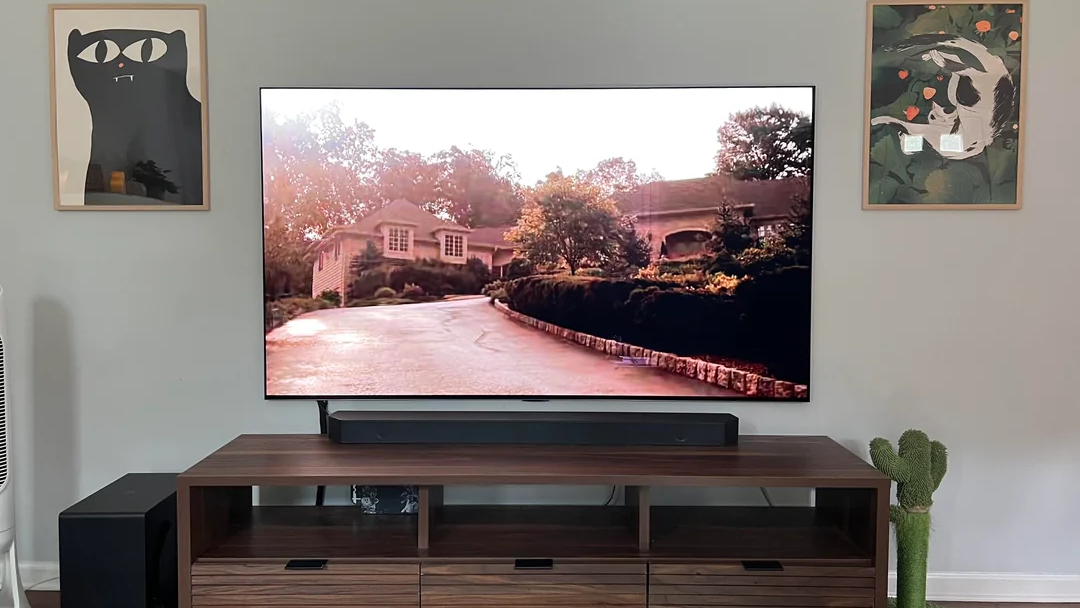Table of Contents
The history of TVs is one of constant innovations, transforming a complicated laboratory concept into an essential household staple. In the early 20th century, it began with mechanical scanning discs, and after that, technology rapidly changed into electronic cathode-ray tubes. This revolutionized picture quality, setting the stage for the post-war period, which is considered the “Golden Age.”
Interested in learning the complete TV history? This blog will not only leap into core technology, but also includes drastic improvements in design, upgrading from mainstream bulky wooden cabinets to sleek flat-panel wireless televisions. Plus, we will also tell you where you can get the latest wireless television from.
The Early Days: Black-and-White Television
The Mechanical TV in the 1920s
The 1920 television was electromechanical. John Logie Baird was the brains behind it. The 1920 TV used a Nipkow spinning disc with holes, which scanned images, leading to small, flickering, and low-resolution black-and-orange pictures. The moving visuals were an initial proof and not a commercial success.

The CRT Technology in the 1930s
In the 1930s, Philo Farnsworth and Vladimir Zworykin shifted attention to all-electronic television. According to PBS, Philo Farnsworth patented his dissector tube in 1927, turning it into an important unit in all-electronic television. The inventors worked on the Cathode Ray Tube and the electronic camera, providing the much-needed superior technology. The Cathode Ray Tube fired an electronic beam onto a phosphorescent screen, forming a much clearer and brighter grayscale image.
Mass Adoption Between the 1940s–1950s
The electronic black-and-white TV dominated households after World War II. Its picture quality was very reliable, and it offered simpler operations, resulting in mass adoption as everyone hurried to buy a television set. This duration was called the “Golden Age,” as the TV was seen as the cultural centerpiece for entertainment and news, which lasted for nearly two decades before the color channels replaced it.
The Shift to Color Television
The Compatibility Hurdle
While shifting to color television, the major technical hurdle in the 1950s was actually developing a compatible color system. Thanks to the NTSC standard for resolving the issue. It layered the color information onto the existing black-and-white signal, letting older sets still display the image in monochrome.
Adopted Slowly and Network Commitment
Color sets were not instantly purchased. Initially, they were complicated to use and expensive too, which discouraged consumers, leading to slow consumer adoption. The mid-1960s were a prominent turning point as NBC committed to broadcasting almost all of its prime-time schedule in color, attracting people to buy and watch colored TVs.
Slimmer Designs: From CRT to Flat Panels
The Bulky CRT Between the 1930s-2000s
Cathode Ray Tube technology dominated the television sets for over half a century. These were quite bulky, large, and deep because they wanted a long vacuum tube to fire electron beams at a phosphorescent screen for image creation.

The Rise of Plasma and LCD in the Late 1990s-Early 2000s
Slimmer designs commercialized flat-panel displays. Early display models utilized Plasma and Liquid Crystal Display technology, replacing the electron gun with light-modulating cells thin layer. This innovation reduced weight, depth, and power consumption.
The Shift to LCD and LED Dominance in the Mid-2000s
LCDs became the market leader by the mid-2000s, ultimately using energy-efficient LED backlights. This shift further boosted the brightness, contrast, and shade, speeding the CRTs' replacement in living rooms. By the late 2000s and early 2010s, the technology was pushed into the ultra-thin television age.
High Definition and Beyond
The Arrival of High Definition (HD)
The Standard Definition (SD) to High Definition (HD) transition marked a monumental jump in picture quality. The SD content had about 480 resolution lines, while HD, being Full HD, offered a huge increase to 1080 vertical lines. This resulted in a four to six-fold pixel increase, providing sharper images, finer details, and a modern 16:9 widescreen aspect ratio. These details closely align with your natural field of view. HD was rapidly adopted in the late 2000s as the digital TV broadcasts rolled out.
The Ultra HD Revolution: 4K in the 2010s
The search for more realistic images, called the Ultra High Definition, is commonly known as 4K. It arrived in the early 2010s. This display contains four times the pixels that Full HD carries, making individual pixels almost invisible and delivering details that enhance the immersive viewing experience on the larger screens. This shift was coupled with High Dynamic Range (HDR), which improved color richness and contrast.
The Future: 8K and Advanced Enhancements
8K UHD is the latest evolution, which goes beyond 4K’s pixel count, offering you 33 million pixels. While native 8K content still has limitations, this resolution goes a long way in driving innovation in AI upscaling to boost lower-resolution sources. Besides resolution, OLED offered perfect blacks, and Micro-LED’s extreme brightness continues to improve contrast, color accuracy, and overall picture depth. This solidified television’s position as a high-fidelity window to view and consume content.

Smart TVs: The Connected Era
What Is a Smart TV?
A Smart TV is an integrated television arrangement with its own internet connectivity and operating system. It appeared in the late 2000s, and by the late 2010s, it was already dominating the market. In short, this technology transformed the TV from a simple receiver into an engaging, all-in-one media hub.

Primary Features and Connectivity
The Smart TV's central appeal lies in on-demand access to content. Primary features comprise built-in apps for major streaming services like YouTube, Prime Video, and Netflix, accessing the app stores, and web browsing. Plus, you will come across features in the shape of screen mirroring and voice control through Alexa and Google Assistant to boost your convenience.
Integration and Operating Systems
Modern models use powerful platforms like Android TV, webOS, and Tizen. These operating systems not just handle media streaming, but also offer recommendations based on your watching style, and function as a smart home hub. This opens the ground for you to manage other connected devices from the TV screen, positioning the TV as the digital home’s centerpiece.
Display Innovations: LCD to OLED and QLED
The LCD and the Backlight Evolution
The Liquid Crystal Display lays the basis for several modern screens. Early LCDs used heavy Cold Cathode Fluorescent Lamp backlights. This changed into the supreme LED-backlit LCD, which makes the most out of Light-Emitting Diodes. The LED backlights are thinner, energy-efficient, and provide better contrast control through local dimming.
The Rise of Self-Emitting Pixels: OLED
Then came the Organic Light-Emitting Diode (OLED) brought the revolution. Each pixel emits its own light and can be individually turned off. This allows for perfect blacks and contrast ratio, offering premium image quality, especially in dark scenes. These panels are extremely thin, providing wide viewing angles, but are vulnerable to “burn-in” and lower brightness levels.
LCD's Quantum Leap: QLED Technology
LED-backlit LCD is Quantum Dot LED’s upgraded version. This wireless television incorporates a film of quantum dots that filter the backlight, allowing for drastically brighter images and a much wider shade gamut than standard LED TVs. QLED performs exceptionally in well-lit rooms and is more reasonable than OLED, but still depends on a backlight, stopping the "perfect black" levels of OLED.
Ultra-Thin and Futuristic Designs
From Bulky CRT to Ultra-Thin Flat Panels
Credits go to the transition from Cathode Ray Tube technology to flat-panel displays for completely revamping television design. The incredibly slim screens replaced the bulky TVs, and LED backlighting in LCDs pushed the thickness down, allowing designs with minimal bezels. This shift changed the TVs to turn into wall-mounted and artistic pieces.
OLED
OLED represents the peak of current displays’ thinness. This wireless television technology doesn’t require a separate backlight layer, as each pixel is self-emissive. Removing the bulk and giving wallpaper-thin designs, where some were just a few millimetres thick. The radical decrease in components has opened the doors for curved, flexible, and even rollable TV concepts. You can fold them or tuck them inside when not in use, merging technology with minimalist interior design.

The Future
Now, the future display designs are concentrating on seamless incorporation in your living spaces. MicroLED guarantees to offer greater brightness and endurance, enabling enormous, modular screens that can be tiled with each other. The futuristic design trend lies in the invisible display. These screens resemble mirrors, artwork, or transparent glass until activated, making the wireless television’s display disappear when you power it off.
What’s Next for Television?
MicroLED Displays
MicroLED is to become the next premium wireless television display. This technology uses millions of microscopic, self-emissive LEDs promising super brightness, perfect blacks, greater energy efficiency, and a wide color gamut. There is no stress of burn-in, ensuring a longer lifespan. Currently, it’s too expensive and modular, but expect efforts to bring these displays to more affordable price ranges and sizes.
New Designs
Apart from vibrant picture quality, even physical designs are evolving. Search for flexible and rollable wireless televisions with stretchable displays. Larger screens are more common, and thinner versions continue to seamlessly merge the display into your home’s environment.
Conclusion
We hope you found the time travel interesting and know about the latest television designs. Furthermore, you can consider GFF-AI S1 mobile TV on wheels to amaze you as a wireless television.





